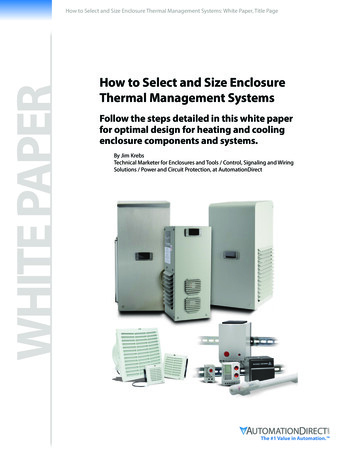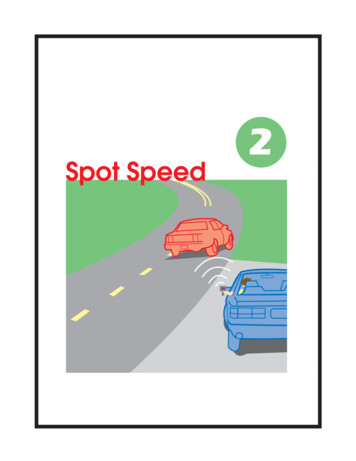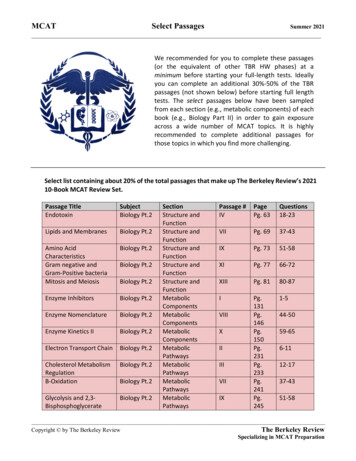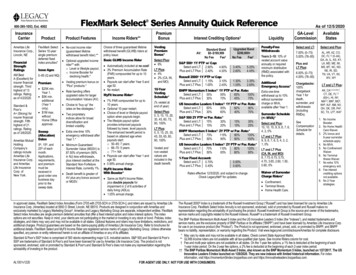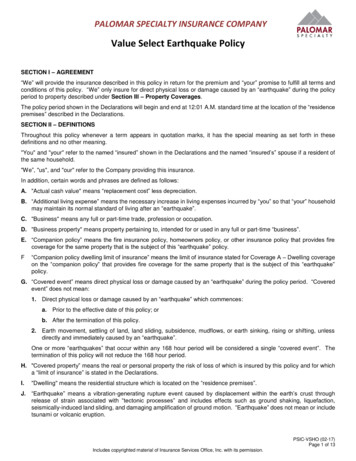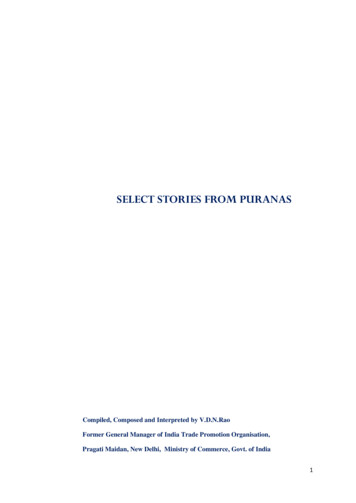
Transcription
SELECT STORIES FROM PURANASCompiled, Composed and Interpreted by V.D.N.RaoFormer General Manager of India Trade Promotion Organisation,Pragati Maidan, New Delhi, Ministry of Commerce, Govt. of India1
SELECT STORIES FROM PURANASContentsPagePreface3Some Basic Facts common to Puranas3Stories related to Manus and )The Story of Surya Deva and his progeny7Future Manus (Savarnis, Rouchya and Bhoutya)8Dhruva the immortal; Kings Vena and Pruthu9Current Manu Vaiwasvata and Surya haga,PradyumnaandIlaDevi)Other famed Kings of Surya e(Budha, Pururava, Jahnu, Nahusha, Yayati and Kartaveeryarjuna)Parashurama and his encounter with GaneshaandMatsya, Kurma, Varaha, Nrisimha, Vamana and Parashurama AvatarasQuick retrospective of Ramayana (Birth of Rama, AranyaSamhara, Rama Rajya, Sita Viyoga, Lava Kusha and Sita-Rama Nidhana)hisVamsha151718Vaasa,21Maha Bharata in brief (Veda Vyasa, Ganga, Bhishma& Pandava-Kauravas &QuickproceedingsofMahaBharataSome doubts in connection with Maha Bharata50Ravana43BattleEpisodes relatedto Shiva and Parvati (Links of Sandhya Devi, Arundhati,Sati and Parvati; Daksha Yagna, Parvati’s wedding, and bitrh of Skanda)52Glories ofMaha Deva, incarnations, Origin of Shiva Linga, Dwadasha Lingas,Pancha Bhuta Lingas, manifesations and Significance of Maha Shiva Ratri55Legends of Venkatachala, Jagannatha and Badari KshetrasEkadasha Vrata-The Episode of King Rukmanga6972Ego clashes of illustrious personalitiesPlay of Maya: the Experiences of Narada Maharshi7376Stories describing the implied messages of Bhagavad Gita Chapters78Origin of Bhandasura, manifestations of Lalita Devi and the killing of BhandaMaha Devi destroys Mahishasura and his clanShumbha and Nishumbha terminated by Maha Devi92Epilogue8390952
SELECT STORIES FROM PURANASPreface:Hindu Puranas are replete with Stories with the moral of destroying Evil and vindicating Virtue.Theydescribe incidents related to Avataras, Devas, Vamshas, Kings, Rishis, Demons, and humanity ingeneral.The underlining message in all the Puranas is that all the Species in the Lord’s Creation - be itDevas or Demons, humanity or other living Beings are bound by the basic Principle ie. one sows asreaps. One’s own ‘Karma’ or action is decided by the previous action in the never-ending cycle ofbirths and deaths. This current action of any Being shapes the future Karma. The Supreme Forcecreates ‘Maya’ or Illusion and influenced by ‘Tri Gunas’ or The Three Characterisics of Satva-RajasTamas Nature, Maya decides each and every action or the Cause which further leads to the Reactionor the Effect! Hence, morality is the crux and behaviour is the corner stone of all Beings, with specialreference to human beings.Veda Vyasas scripted Eighteen Main Puranas besides several Upa-Puranas. The Main Puranas areBrahma Purana, Brahma Vaivarta Purana, Brahmanda Purana, Bhagavata Purana, Vishnu Purana,Matsya Purana, Kurma Purana, Varaha Purana, Vamana Purana, Shiva Purana, Linga Purana, SkandaPurana, Markandeya Purana, Agni Purana, Narada Purana, Padma Purana, Bhavishya and GarudaPurana. Some of the prominent Upa Puranas include Deva Bhagavata, Narasimha, Vayu, Sthala,Nilamata Puranas.Some basic facts common to PuranasThe Unknown and Eternal Paramatma or The Supreme Energy materialised the Alternate Powercalled Prakriti / Maya which further appeared as Maha Tatwa or the Great Awareness. The latter madepossible the occurrence of ‘ Ahamkara’ or Ego in Abstract Form or the Inherent Consciousness whichgot transformed as Bhutas or Tangible Entities the very First Entity being Narayana who created ‘ApoNaara’ or the Radiant Water who floated on that Water and was hence called Narayana. He depositedhis virility with the resolve of creating and there got manifested a Brahmanda, the Huge Golden Egginside which there was seated Hiranya garbha Brahma. The Egg had two parts viz. Diva/ UrthwaLoka or the Upper Part and ‘Bhuva’or Earth and the Space between these Parts was ‘Akaasha’ theSky. There were manifestations eventually of Sapta Lokas (Bhuloka, Bhuvarloka, Swarloka,Maharloka, Janarloka, Tapoloka and Satyaloka), Sapta Patalaas ( Atala, Vitala, Sutala, Talaatala,Mahatala, Rasatala and Patala); Dasha Dishas or Ten Directions viz. Uttara or North-East or PurvaDakshina or South-Paschim or West-Ishanya or North East -Agneya or South East-Nirruti or SouthWest- Vayavya or North West-Urthwa or Upper Region and Atho Lokas or the Nether Worlds; SaptaDwipas (Jambu, Plaksha, Salmaali, Kusha, Krouncha, Shaka and Pushkala); Sapta Samudras (Lavanaor Salt, Ikshurasa or Sugarcane juice, Sura or Wine, Ghrita or Classified Butter, Dahi or Curd,Ksheera or Milk and Suswada or Sweet Water); Sapta Parvatas (Sumeru , Kailas, Malaya, Himalaya,Udyachala, Agastyachala, Suvela and Gandhamadana); Ashta Loka Palakas (Indra, Agni, Yama,Nirruti, Varuna, Vayu, Kubera and Ishana); Kaal maana or Time Calculation (Triti-hundred tritisoneVedha- three Vedhas one Lava-Three Lavas on Nimesha- Three Nimeshas one Kshana- fivenimeshas one kashta or eight seconds- fifteen kashtas one laghu or two minutes- fifteen laghus onedanda- six to seven dandas one fourth of a day or night-four praharas or yamas one day or night- twopakshas a month-two months a Ritu or Season- Six months one Ayana-365 combinations of a day /night one year- one year a Deva year-1200 Yugas comprising Satya of 4800 Deva Years, Treta Yugaof 3600, Dwapara of 2400 and Kaki yuga of 1200 Deva Years make one a Maha Yuga-100 Maha3
Yugas one Kalpa and Two Maha Kalpas are one life time of Brahma; Brahma is now passing throughhis fifty first year and his life span is 100 such years; we are now in the 28th Kali yuga of the first dayof the first year of the third Sweta Varaha kalpa, second paraartha in the reign of the Seventh Manunamed Vivaswanta. Kali Yuga is calculated to have commenced on 17th February 3102 BC of JulionCalendar). Besides the Kaala maana (Time), other notable creations were Manasa (Thought), Vaak(Speech), Shad Vargas or the Six Aberrations of Kama-Krodha-Lobha-Moha-Mada- Matsara viz.Desire, Anger, Greed, Infatuation, Arrogance and Jealousy; as also: Pancha Bhutas viz. Earth, Water,Agni,Wind and Sky; Nava Grahas of Surya, Chandra, Mangala, Budha, Guru, Shukra, Shani, RahuKetu; Chatur Vedas of Rik-Yajur-Saama and Atharva besides Shat-Vedangas viz. Siksha includingSangeeta and Nayaaya, Vyakarana, Kalpa Grandha, Nirukta, Chandas Shastra and Jyitisha. EkadashaRudras or Eleven Rudras viz. Mahaan, Mahatma, Matimaan, Bhishana, Bhayankara, Ritudwaja,Urthwakesha, Pingalaksha, Rucha, Shuchi, and Kalaagni; Sapra Rishis viz. Marichi, Atri , Angirasa,Pulastya, Pulaha, Kratu, and Vasishtha;Four Kumaras viz. Sanaka, Sanandana, Sanat and Sanatana;besides Narada-all Brahma’s mind-born sons.; Chaturashramas,Yagnas and Agni Homas like Shodasi,Ukta, Purushi, Agnishtoma, Aptoryama, Atiratra, Vajapeya, Goshava etc. Other facts worth noting inthe context of Puranas are Fourteen Manvantaras (Swayambhu, Swarochisha,Uttama, Tamasa,Raivata, Chakshusa, the present Vaivaswata, Savarni, Bhoutya, Rouchya and four more Savarnyas)and Prajapatis and Vamshas, especially of Surya and Chandra and their lineages.Daksha Prajapati and his wife Prasuti had sixty daughters, ten of whom were given in charity toDharma, seventeen to Kashaypa Muni, twenty seven to Chandra and two each to Rishis Angira,Krasaswa and Bhuta. Dharma’s wives gave birth among others to Twelve Sadhyas called Jaya Devasconsidered as good as Devas reputed in the context of Yagnas like Darsha, Pounamavasya, Vithi,Vivithi etc. Dharma’s another wife Vasu gave birth to Ashta Vasus like Dhara, Soma, Ayu, Pratyusaetc. From Angirasa and Vastu Devi was born Vishwakarma and so on. But the most significantprogeny of Daksha’s daughters was from Kashyapa Muni as follows: Indras and Devas from Aditi;Diti gave birth to Daityas like Hiranya Kashipu (killed in Narasimha Avatara as he tormented hisown son Prahlada) and Hiranyaksha (who dragged Bhu Devi to Rasatala but was rescued by Vishnu’sAvatara viz. Matsya Deva) as also Marudganas ( when Diti performed a very severe Vrata to destroyDevas and got conceived from Kashyapa, Indra feigned affection to Diti and when she was asleepentered her womb and by his ‘Siddhi’called ‘Anima’or miniaturasing cut the child seven times by hisVajrayudha and made further seven pieces totalling forty nine and after delivery each piece became aMarud by Kashyapa Muni’s powers and the Marudganas turned out to be share-holders of Yagnas andas good as Devatas and were Indra’s followers!); Danu Devi gave birth to Danavas whose Chief wasViprachit and the latter’s wife Simhika gave birth to Simhika who were more cruel and notorious thanDanavas in grit for Tapasya, mainly targetting Sages and Brahmanas. Rahu was the eldest son ofSimhika; the most infamous among the Simhikas were Vatapi, Bhouma and Namuchi. The worst ofDanavas were Shambhara, Maya, Tarakasura, Jambha, Naraka, Pralamba etc. who had passion fordestroying Yagnas, Shraddhas, children and cows too. Devi Kadru another wife of Kashyapa Muniwas the mother of Serpents, the most famed ones of the species being Sesha, Vasuki and Takshakabesides Iravata, Mahapadma, Kambala, Ashwatara, Shankha, Karkotaka, Dhananjaya, Kaliya and soon. Khasa Devi had two sons one at dawn time and another at dusk; the elder son had four hands andfour legs with high hair growth all over his body and the younger one had three heads, three handsand three legs. Bothe were ferocious and grotesque; one wanted to eat his mother out of extremehunger and another desired to save the mother. Kashyapa named them Rakshasas; they were weakand dull but as the dusk grew into night they became invincible and all powerful with the ability tochange into any Form as they wished enjoying the flesh of Devas, Sages, human beings, animals orbirds. Surabhi was the mother of cows and buffalos; Vinata the mother of Garuda and Aruna the4
charioteers of Vishnu and Surya; Arista gave birth to Gandharvas; Muni was the mother of Aprasasor Angels; ILA Devi was the mother of creepers; Tamra gave birth to vultures, eagles and largebirds; Timi to acquatics and Saras to tigers, lions and ferocious animals. Thus Kashyapa Vamshastood for Dharma, Kshama, and Virtue and at the same time for Adharma, jealousy, cruelty andsheer depravity.Stories related to Manus and VamshasAs the pace of Creation in the Universe was slow at the beginning, Brahma divided himself into twoone as himself and another as a female called Shatarupa. The latter did Tapsya for ten thousand yearsand begot a husband named Swayambhu Manu born on his own. Manu and Shatarupa gave birth toVeera, Priyavrata and Uttanapada.Priyavrata ruled Sapta Dwipas of which Jambu Dwipa was a part of Bharata. In his childhoodPriyavrata secured Brahma Gyan (Enlightenment) and declined to marry. Manu admonished his sonthat he was too young to become an ascetic and the Almighty created human beings to pass throughchildhood, student life, married life, detachment an renunciation and that the golden rule of marriedlife should be like that of a dew on a lotus leaf and so on. Finally, Privavrata ended up with twowives; he had the distinction of travelling by his chariot and earmarked the entire Bhu Loka into SaptaDwipas and entrusted the Seven Dwipas to be entrusted to his sons.Varudhini and Pravarakhya: The births of King Swarochi and Manu Swarochisha had aninteresting background. A learned Brahmana youth called Pravarakhya on the banks of River Varunaobserved the required rituals regularly and worshipped guests. Once a Siddha who had knowledge ofMantras, Tantras and especially of indigenous herbs and their usages arrived and Pravarakhya evincedinterest to visit Himalayas; he gave an exotic herb and asked the youth to apply its ‘lepana’or itsessence on his feet and he could visit Himalayas instantly by closing his eyes. But the Siddhacautioned that the lepana would dry up by the Sunset. Indeed, Pravarakhya landed in the thick junglesatop Himalayas and was lost in an unparalleled vision of ice mountain linings and the abundant gloryof flora and fauna, the dizzy views of valleys, waterfalls etc. The youth was fully conscious that hewould have to return by the dusk time. In that place of blissful silence, he spotted a damsel-an Apsaranamed Varudhini- and initiated conversation; the friendly dialouge ended up with her sincere entriesto marry her ; when she was refused , she begged him to atleast mate with her once. Pravara a strictBrahmachari of proven celibacy ran away from her and in the process his lepana on his feet got driedup and he lost his way. As he was badly delayed for his evening rituals back home he prayed to AgniDeva who in the form of an elderly Brahmana appeared and reached him home. Meanwhile thefrustrated Varudhini became too passionate for Pravara. A Gandharva boy he was rejected byVarudhini earlier got scent of the situation and having changed his Swarupa as a Maya Pravarakhyaapproached her and said he changed his mind and cheated her into bed on the condition however thatshe should close her eyes at the time of their union so that she would not realise that he was not thegenuine Pravara . Varudhini and Maya Pravara lived together for a year and Swarochi was born ofPravara’s intellect and discipline and Varudhinis’s charm and physical attraction.Swarochisha Manu’s story was far more interesting. Once King Swarochi he was wandering in aforest aimlessly and heard a desperate female voice in great anguish as though was being chased.Soon enough, the female appeared and requested Swarochi to save her by a demon; she said that sheknew some ‘Astras’or Mantrik Arrows from her dead father and he could save her from the Danavawho was chasing her. Swarochi t
SELECT STORIES FROM PURANAS Compiled, Composed and Interpreted by V.D.N.Rao Former General Manager of India Trade Promotion Organisation, Pragati Maidan, New Delhi, Ministry of Commerce, Govt. of India. 2 SELECT STORIES FROM PURANAS Contents Page Preface 3 Some Basic Facts common to Puranas 3 Stories related to Manus and Vamshas 5 (Priya Vrata, Varudhini &
